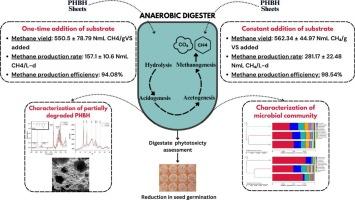聚(3-羟基丁酸酯-co-3-羟基己酸酯)(PHBH)生物塑料的间歇和半间歇厌氧消化:新的动力学、结构、微生物学和消化植物毒性见解
IF 8
1区 环境科学与生态学
Q1 ENVIRONMENTAL SCIENCES
引用次数: 0
摘要
本研究研究了聚(3-羟基丁酸酯-co-3-羟基己酸酯)(PHBH)在间歇和半间歇厌氧消化系统中的生物转化,不仅关注甲烷产量和微生物群落动态,还关注降解过程中发生的结构变化以及所产生的消化物作为土壤增强剂的潜在用途。两种系统均在中温环境(37±2°C)和稳定pH(7.9±0.2)下运行。该间歇体系的甲烷产率为550.5±78.79 NmL /g VS,并具有典型的s型甲烷产型。碳质量平衡分析表明,回收率为96.09%,其中47.62%的碳转化为甲烷。部分降解材料的SEM、FTIR和XRD分析表明,PHBH的厌氧生物降解表现为表面侵蚀和失重,结晶度变化很小。相反,微生物群落对连续PHBH饲喂93天的适应使得甲烷产率稳定在562.34±44.97 NmL CH₄/g VS,相应的体积甲烷产率为281.17±22.48 NmL CH₄/L-d。拟稳定状态下的微生物群落分析显示,Methanosaeta、Anaerolineaceae和Thermovirga在通过丙酮裂解产甲烷作用推动PHBH厌氧消化方面具有优势。尽管甲烷生产效率很高,但使用多年生黑麦草进行的消化毒性试验表明,植物毒性对种子萌发有影响,这突出表明需要进一步研究,以表征抑制化合物并制定缓解策略。本文章由计算机程序翻译,如有差异,请以英文原文为准。

Batch and semi-batch anaerobic digestion of poly(3-hydroxybutyrate-co-3-hydroxyhexanoate) (PHBH) bioplastic: New kinetic, structural, microbiological and digestate phytotoxicity insights
This study investigated the bioconversion of poly(3-hydroxybutyrate-co-3-hydroxyhexanoate) (PHBH) in batch and semi-batch anaerobic digestion systems, focusing not only on methane production and microbial community dynamics, but also on the structural changes that occur during degradation and the potential use of the resulting digestate as a soil enhancer. Both systems operated under mesophilic conditions (37 ± 2 °C) and stable pH (7.9 ± 0.2). The batch system achieved a methane yield of 550.5 ± 78.79 NmL CH₄/g VS added over 50 days, with a typical sigmoidal methane production pattern. A carbon mass balance analysis indicated a 96.09 % recovery, with 47.62 % of the carbon converted to methane. SEM, FTIR and XRD analyses of the partially degraded material showed that the anaerobic biodegradation of PHBH was characterized by surface erosion and weight loss, with minimal changes in crystallinity. Conversely, the adaptation of the microbial community to 93 days of continuous PHBH feeding allowed the achievement of a stable methane yield of 562.34 ± 44.97 NmL CH₄/g VS added, along with a corresponding volumetric methane production rate of 281.17 ± 22.48 NmL CH₄/L-d. Microbial community analysis, at pseudo-steady state, revealed the dominance of Methanosaeta, Anaerolineaceae, and Thermovirga in driving the anaerobic digestion of PHBH via acetoclastic methanogenesis. Despite high methane production efficiency, digestate toxicity tests using perennial ryegrass indicated phytotoxic effects on seed germination, highlighting the need for further investigation to characterize inhibitory compounds and develop mitigation strategies.
求助全文
通过发布文献求助,成功后即可免费获取论文全文。
去求助
来源期刊

Science of the Total Environment
环境科学-环境科学
CiteScore
17.60
自引率
10.20%
发文量
8726
审稿时长
2.4 months
期刊介绍:
The Science of the Total Environment is an international journal dedicated to scientific research on the environment and its interaction with humanity. It covers a wide range of disciplines and seeks to publish innovative, hypothesis-driven, and impactful research that explores the entire environment, including the atmosphere, lithosphere, hydrosphere, biosphere, and anthroposphere.
The journal's updated Aims & Scope emphasizes the importance of interdisciplinary environmental research with broad impact. Priority is given to studies that advance fundamental understanding and explore the interconnectedness of multiple environmental spheres. Field studies are preferred, while laboratory experiments must demonstrate significant methodological advancements or mechanistic insights with direct relevance to the environment.
 求助内容:
求助内容: 应助结果提醒方式:
应助结果提醒方式:


